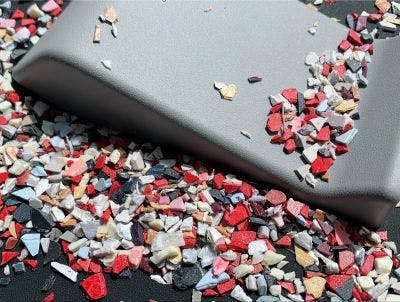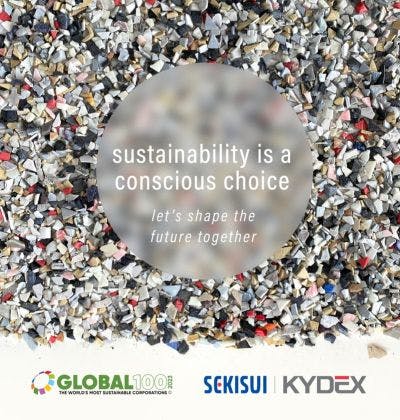By Sean Fenske, Editor-in-Chief of Medical Product Outsourcing
The environment has always been important to some companies, but it seems an increasing number of firms are becoming more aware of their own impact. Within the last decade, sustainability within manufacturing has garnered interest as a growing contingent of customers want to buy products from responsible organizations. For any medical device manufacturing exploring this route, it’s critical they understand what sustainable materials could mean for their development projects.
Sustainability as it relates to the sourcing of materials ties into the physical properties required for a project. While quality and certain performance criteria cannot be sacrificed, being aware of the environmental impact of using one material over another can begin companies down a more socially responsible path.
To help organizations navigate that path, Mark Denning, medical market business manager at SEKISUI KYDEX, has addressed a number of questions around sustainability in medical device design within the following interview. He tackles material selection, sourcing responsibly, and factors to consider before starting your next project.
Sean Fenske: In terms of material properties for a new medical device, where does sustainability rank in terms of importance?
Mark Denning: It varies. Many important factors are required for medical device innovation, such as material properties for regulation, chemical resistance, design freedom, and sustainability. The ranking for sustainability differs depending on the OEM (original equipment manufacturer) and what they consider sustainable, as well as the requirements for the device itself.
While some OEMs prioritize utilizing sustainable materials, there are still more questions than answers. OEMs should ask themselves if having a low environmental impact with material selection is important. If so, can the device use a product with recycled content, and can that material be reprocessed to have another life once the device is retired?
Fenske: As a manufacturer, how do you see your role in contributing to sustainability?
Denning: We believe it is part of the material manufacturer’s responsibility to provide viable solutions and do their part in ensuring materials don’t reach landfills. By managing edge trim during production as well as collecting the material from our processing partners, SEKISUI KYDEX recycled over 20,000,000 pounds (9,000,000 kg) of material between our three sites in FY2022. We are constantly working to close the loop with OEM partners and developing channels for end-of-life covers and housings to repurpose materials into new recycle-grade materials or into a different application.

Ultra-Poly is an in-house recycling partner of SEKISUI KYDEX.
We were recently contacted by an OEM regarding collecting and recycling expired covers. We have implemented a collection program with them, so as their retired covers are coming in from the field, the material is shipped to our in-house recycling partner, Ultra-Poly, to be pulverized into reusable resin.
If an OEM allows regrind content, we proudly support their initiative. For example, inside our facility in Holland, Mich., we collect all edge trim from our thermoforming partners to reincorporate it back into the manufacturing process for their next order of the same material. Alternatively, these recycled materials can be used in a number of other applications, such as the park bench in your community, which could be made from a retired MRI machine cover, or the wastewater pipe in your municipality, which could have been constructed from an expired IVD machine.
Fenske: Is sustainability a one-step solution or a complicated process?
Denning: The process begins with material selection and an analysis of its lifecycle. This assessment helps to put in place a value or measurement that can be followed and factors in the source and destination of the material, as well as the raw ingredients and processes used to create it.

KYDEX thermoplastics can be recycled and used for new applications.
Sustainability can sometimes be overlooked when exploring material options. It is not only about using recycled grade material or finding a recycling solution; the device’s longevity in the field is also important. Once material becomes brittle, cracked, or fails due to disinfectants, this creates waste, and new parts must be produced, shipped, and re-installed.
Durable and plasticizer-free KYDEX® Thermoplastics offer chemical resistance to withstand increased sterilization and disinfecting procedures. Painting is unnecessary with integral color, which reduces harmful VOCs. Additionally, the material chemistry of PVC/acrylic-based materials is safe for medical facilities.
Fenske: What is driving the interest in the use of sustainable materials?
Denning: Overall, society is becoming more and more conscientious of our impact on the earth and the depletion of its resources. No one wants to see their company’s logo on an end-of-life cover in the back of a truck heading toward the landfill, so businesses are taking on more responsibility for their waste. By controlling the cause of the waste, starting with responsible material selection, we can minimize adding more to the landfills.
Fenske: In terms of fabrication processes, are there any limitations? Are sustainable materials able to be used in any molding, additive manufacturing, or other process just like any other material?
Denning: They can be; it depends on the material and the chemistry of the product. For example, KYDEX® sheet and injection molding products are all 100% recyclable. However, other materials used in these processes may not be.

Sekisui Chemical Co Ltd was included on the Global 100 list of most sustainable companies.
SEKISUI KYDEX has co-extrusion capabilities for its ALLEN® Thermoplastics product line, meaning the sheet has a virgin cap layer over a recycled material. This is processed by our partners without any limitations. Also, we produce a recycled utility-grade product made from KYDEX® Thermoplastics regrind. This material is used by some leading medical device manufacturers for medical housings or covers.
Fenske: What aspects regarding the use of sustainable materials are not often considered or overlooked? Are there factors that need to be decided to ensure the material is suitable for a project?
Denning: OEMs should view sustainable material solutions as a responsibility, not as cost savings. There are expectations that recycled materials are less costly, and this is not always the case. Recyclable materials are captured, sorted, and processed before being reintroduced back into the feedstock, which impacts overall cost. Additionally, quality expectations may require virgin material resin to be combined with recycled content to reach the desired result.
We suggest inquiring with your material supplier about their approach to sustainability to understand if it satisfies your goals.
Fenske: Do you have any additional comments you would like to share based on any of the topics we discussed or something you would like to tell medical device manufacturers?
Denning: Compromising the design isn’t required to be sustainable; however, careful planning is. In order to utilize sustainable materials, begin with material selection and education about your supplier’s sustainability initiatives.
Click here to learn more about SEKISUI KYDEX's Sustainability Promise >>>>>
This article was originally posted on Medical Product Outsourcing
About SEKISUI KYDEX
SEKISUI KYDEX innovates and creates sustainable thermoplastic material solutions for the next generation of product design. SEKISUI Chemical’s corporate commitment to Speed, Service, and Superiority is realized through the KYDEX® Thermoplastics business model of manufacturing bespoke materials with short lead times in small quantities. This Quick Response Manufacturing (QRM) model at three manufacturing campuses expands beyond thermoplastic sheet. The KYDEX® portfolio also includes injection molding resins, proprietary Infused Imaging™ technology, integral special effects, unique textures, and custom products and design. The SEKISUI KYDEX appLab™ and designLab® Innovation Centers are collaborative spaces for clients and customers to bring the supply chain together for rapid prototyping and design development. These spaces are the bridge between engineering and art. More than 300 dedicated professionals in Bloomsburg, PA, and Holland, MI, working with a global network of sales and distribution partners, are committed to delivering more than their customers can imagine. Visit www.kydex.com for more information.





